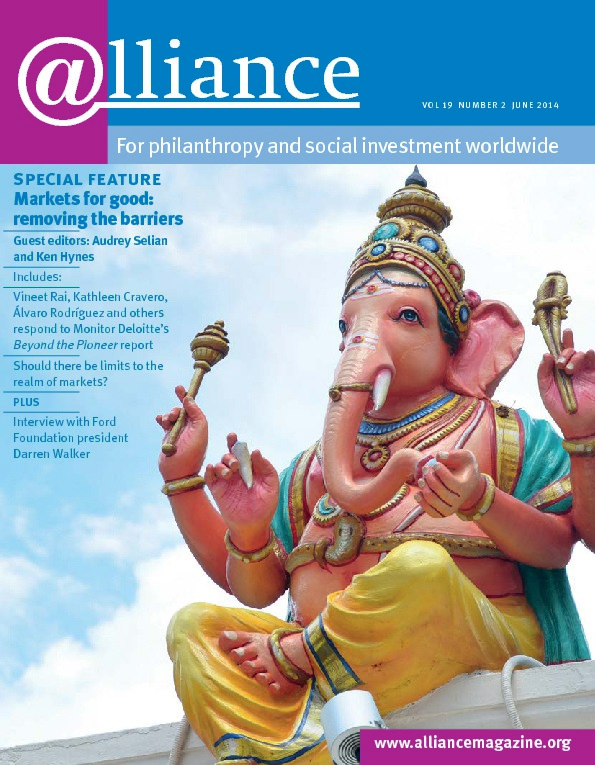When we wrote Beyond the Pioneer, we said that we intended for it to begin an important conversation about how we should best use market-based solutions for social impact. We are thrilled to see that it has, not least from reading the array of insights and questions raised in this issue of Alliance. What follows are our initial responses to some of them.
Market-based solutions are only one aspect of innovation in the fight against poverty
As Martin Brookes rightly points out, market-based solutions are no panacea. There are many areas of life in which markets cannot – and, sometimes, should not – operate. Even within the sphere of market-based solutions, there are many situations that still require philanthropic support in addition to investment capital, as we have described in Beyond the Pioneer and, before it, in From Blueprint to Scale. It would be dangerous indeed for philanthropic donors to assume that all social change will eventually be subsumed into the mainstream capital markets. All of us working for social change must carefully weigh the choices we make, considering both the impact we wish to achieve and the resources we have at our disposal. As Fabio Segura points out, it is impact that is key, not the emergence or success of firms per se.
The reality, however, is that many of the poor are already engaged in markets that leave them at a severe disadvantage. They borrow money at exorbitant rates from moneylenders, live in unsanitary housing rented from slum landlords, buy contaminated water from private water tankers, and seek healthcare from unlicensed medical practitioners. Meanwhile, they eke out a meagre living from menial jobs or tending small plots of land, unable to improve their skills and productivity or to connect themselves to more vibrant markets that could pay them better. The majority of the market-based solutions that we come across insert themselves into, or are attempting to displace, these low-quality market arrangements, so that the poor get a better deal out of engaging with other buyers and sellers.
Many beneficial products involve some degree of ‘push’
Displacing these arrangements is not always easy, especially where tough scaling barriers stand in the way. This is particularly pronounced with ‘push products’ that are beneficial but not readily desired by consumers. Álvaro Rodríguez Arregui calls this ‘one of the impact sector’s biggest traps’. We certainly think that conflating consumer needs with their wants, or projecting developed-world or higher-income consumer preferences on to poor people, are common pitfalls.
In our experience, though, many beneficial products have some degree of push associated with them. For instance, while we initially see strong demand for early childhood education (ECE) among low-income parents in Indian cities, it appears upon closer inspection that most of the consumer pull might be for an age-inappropriate kind of ECE, with uniforms, regimented classrooms and relentless drilling in the 3Rs, rather than an approach which is play-based, interactive and child-centric, which is more of a push product.
As Rodríguez says, investors need to decide how much risk they are willing to take investing in products involving some degree of push. But the calculus is different for philanthropic donors because they are looking for the best ways to achieve a specific impact. They may be willing to invest in a push product because the expected result is better than the alternatives available. In the ECE example, a donor might decide that funding such interventions charitably would be unaffordable (or, conversely, benefit too few children), or that trying to persuade government agencies to deliver this would be too difficult.
Industries are a helpful unit of analysis, but they are not static
We have been deliberate in focusing on industries because this allows us to have a meaningful discussion of the various aspects of any given solution, including its impact and its commercial viability. It also allows us to work out what scaling barriers are in the way and how we might begin to address them. Unlike Vineet Rai, we see the MFI industry as clearly distinct from mainstream commercial banks, using a new business model to serve a group of borrowers previously unserved by formal financial services providers, and facing a very particular set of challenges.
However, industries are not static. The MFI India case study in our report shows
how business models evolve to more efficiently serve customers and to better access capital. We would argue that the granting of a banking licence to Bandhan has the potential to result in a new hybrid model unlike either existing MFIs or mainstream commercial banks. In Kenya, Equity Bank is a building society that became an MFI and then turned into a commercial bank. However, it continues to focus on low-income communities: Equity Bank’s agency banking platform now has nearly 7,000 agents bringing over 2 million low-income customers into the fold of formal financial services.
There is a tension between public good and private competitive advantage
Rodríguez argues that industry knowhow and market information could be a private competitive advantage for a firm, and not a public good. The truth is that they could be either, depending on who is in possession of such information. Certainly, we have no issue with firms building up such knowledge themselves.
However, in the ‘pre-competitive’ space where industries are first formed, firms do not always generate this on their own. In our own work in low-income housing in India, we invested years of work in profiling target customers, publicizing the market opportunity, and encouraging property developers to dip their toe in the water, before the market realized the extent of the opportunity and began to move. A key aspect of our approach was to place the key findings from our work in the public domain, and then to actively promote them to potential industry entrants and stakeholders. Today, the industry is increasingly competitive and the needs of players have evolved accordingly.
However, there remain some areas where public good information is under-provided by the market and where we continue to be active. One example is our ‘Unintended Consequences’ project where we are tracking customer experiences and outcomes over a number of years, so that we can pick up both the intended and unintended consequences of our low-income housing model. As we point out in our report chapter on sustaining scale, and as highlighted by guest editors Audrey Selian and Ken Hynes, the incorporation of formal feedback loops is likely to be key to long-term resilience for industries.
Those taking on industry facilitation need to be in the right role
We are delighted that the various contributors to this issue recognize that both impact investors and foundations can play roles in industry facilitation. Certainly, our own work has been carried out in partnership with both groups.
Geeta Goel points out that foundations have a strong natural fit with the industry facilitation role because they have the flexibility and mandate to operate at a broader, sectoral level. Meanwhile, Justin Highstead emphasizes the need for foundations to be patient and willing to take risks, while David Knopp highlights the importance of agility when operating in dynamic market environments. Rodríguez describes how investors, with their in-depth understanding of a firm’s challenges, can be well placed to help resolve them, for instance by engaging with government. And we can only applaud the string of great suggestions for investors outlined by Audrey Selian and Ken Hynes, from investing in a field or portfolio of companies in a sector to looking for the right opportunities to cooperate.
In all of this, actors must be alive to their own strengths and limitations, and clear about where they can play a part. Rodríguez’s work at IGNIA describes this well. He highlights the ability of investors to engage with policymakers and regulators. But there will be other situations with very different needs, such as where pre-competitive market information needs to be generated to attract new entrants, or where consumer awareness of a product with significant pull characteristics needs to be raised through a social marketing campaign. Foundations could potentially work more easily in these areas, and in ways that may be complementary to IGNIA’s work later on.
Industry facilitation is fundamentally a local effort
A clear theme running through all the industry facilitation we have described in the report, and all the pieces referred to above, is the strong local aspect of the work. While there can be supporting elements of facilitation that cut across countries and continents, the real magic is what happens on the ground. Customers, producers and companies are local, as are government actors, and the close relationships needed for effective facilitation make it difficult to project industry facilitation into distant places. And because not all actors will be able to have a local presence, it is important that we think about how we use partnerships (or networks, as Selian and Hynes describe) to achieve the changes we wish to see.
Harvey Koh is a director at Monitor Deloitte and co-leads the Monitor Inclusive Markets unit based in Mumbai, India. Email inmim@deloitte.com




Comments (0)